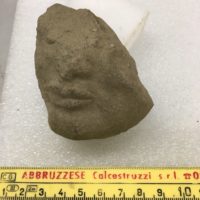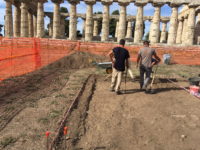 A fragment of a late-archaic stone head has been unearthed at the ancient Greek Temple of Athena at in Paestum, near Salerno in southern Italy. The three-quarter profile portrait of a face is made out of sandstone. What’s particularly significant about this modest piece is that the posterior surface is unfinished. Archaeologists believe that it is an architectural feature, perhaps from the metope of the temple, which would be the first remnant of the metope discovered in the sanctuary of Athena.
A fragment of a late-archaic stone head has been unearthed at the ancient Greek Temple of Athena at in Paestum, near Salerno in southern Italy. The three-quarter profile portrait of a face is made out of sandstone. What’s particularly significant about this modest piece is that the posterior surface is unfinished. Archaeologists believe that it is an architectural feature, perhaps from the metope of the temple, which would be the first remnant of the metope discovered in the sanctuary of Athena.
Paestum was founded by Greek colonists around 600 B.C. and is famous for its three Doric temples dedicated to Hera and Athena. They are some of the best preserved early Greek temples in the world. The Temple of Athena was built around 500 B.C., after the first temple dedicated to Hera but before the second.
Before this find, the only stone reliefs from Paestum area temples came from the 6th century B.C. Temple of Hera at Foce del Sele, outside of Paestum. The temple itself is destroyed, but about 70 of the metope relief panels have been discovered and are now in the Paestum Archaeological Museum. The earliest Temple of Hera in Paestum, known as the “Basilica” due to a historic misconstrual of its surviving colonnade as a Roman building, is estimated to have had around a hundred sculpted reliefs in the frieze above the architrave, but no trace of them has been found. The discovery of the sandstone face opens up new possibilities that the Temple of Athena may have had a similar frieze.
 The team of archaeologists from the University of Salerno has been digging in the southeast of the structure, an area where painted terracotta architectural fragments, some of the oldest material remains from this part of the site, are believed to have been found. The discovery sculpture is an indication that the sacred enclosure of the temple, excavated in the 1920s and 30s, still has surprises in store for archaeologists.
The team of archaeologists from the University of Salerno has been digging in the southeast of the structure, an area where painted terracotta architectural fragments, some of the oldest material remains from this part of the site, are believed to have been found. The discovery sculpture is an indication that the sacred enclosure of the temple, excavated in the 1920s and 30s, still has surprises in store for archaeologists.
The excavation is open to the public every weekday between 12:00 and 12:30. Visitors can see the archaeologists at work, ask questions and learn about the archaeology of Paestum from the horses’ mouths, so to speak.